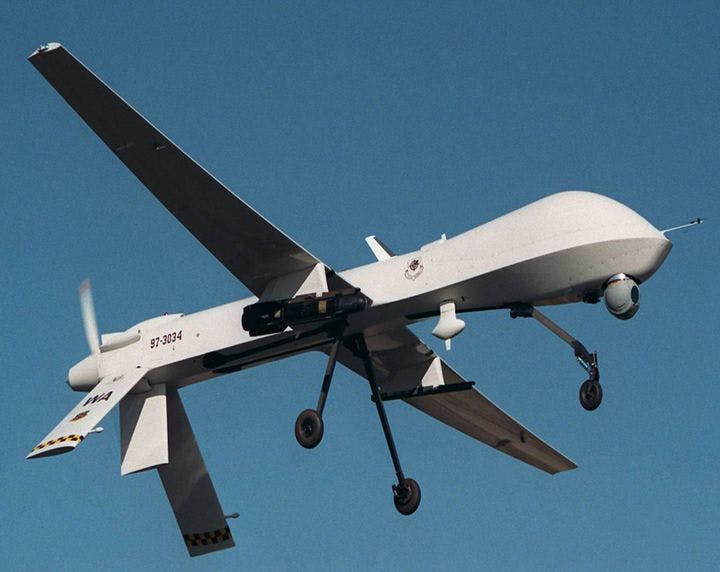Drones have decreased the risk of military acts — with major downsides
– Eric Nong
The nature of drone warfare has decreased financial (and, most importantly, human) risk. This has allowed military and political leaders to more freely sanction these operations.
World War I saw the first extensive use of aerial warfare (including early fighters and bombers alongside observation balloons) for combat purposes. As early as World War II, the United States Army Air Corps — the predecessor of the U.S. Air Force — began experimenting on unmanned aircraft in the Western European theater with the intention to save the lives of Allied pilots. Though those initial experiments proved largely fruitless, they foreshadowed a revolution in combat that the pilots and their commanders from both World Wars could scarcely have imagined.
Armed and unarmed drones (formally known as an “unmanned aerial vehicles,” or UAV) have played a major role in U.S. military operations under Presidents George W. Bush and Barack Obama. Using these drones for surveillance and airstrikes abroad and at home, American drone use has inspired necessary ethical questions regarding their role in national security. But, as Sarah Kreps and Micah Zenko note in Foreign Affairs, the recent global proliferation of drones is signifying the end of America’s “relative monopoly” on drone technology as a military option. Even though the authors do not see this proliferation as something that could radically subvert the current international system of warfare, these developments could have region-destabilizing effects.
Kreps and Zenko criticize the Obama administration for “failing to develop a comprehensive strategy to limit the proliferation of armed drones and promote their responsible use.” They believe that international laws must be written to curtail the proliferation and potential overuse of drone technology. A lack of ethical consensus and international precedent regarding drone warfare and the Obama administration’s record use of drone strikes is only encouraging other states to construct their own.
Only three nations have admitted to executing a drone airstrike — Great Britain, Israel, and the United States — but many others are suspected of having launched such strikes, albeit without an admission. Dozens of nations, including China, India, Iran, and Pakistan are known to possess armed drones, and the authors note that while 41 nations had (armed or unarmed) drones in 2004, by 2011, that number rose to 76. Kreps and Zenko suspect that many other nations have UAV programs, but keep them under wraps. Though the true number remains shrouded, there’s a clear reality: drone proliferation is progressing faster than international efforts for deliberation on the topic.
Refuting the claim that drone warfare “represent[s] not a paradigm shift but just a different way for states to do what they have done for decades,” Kreps and Zenko contend that the improbability of a drone pilot’s death has altered the process by which states possessing drones might consider executing a drone strike. The nature of drone warfare has decreased financial — and, most importantly, human — risk; this has allowed military and political leaders to more freely sanction these operations.
Without transparency, regulation, or civilian oversight in the United States, there have been few obstacles to deter the president or military officials from authorizing drone usage. Kreps and Zenko recommend that the U.S. dismantle the secrecy shrouding its drone policy through increased regulation and public Congressional oversight. This would encourage other nations with drone technology to declassify information on the tasks its drones complete. Moving forward, this could set the foundations of international agreements on the manufacturing, export, and use of drones as the technology develops.
Kreps and Zenko do not believe that the global proliferation of drones will alter the nature of interstate war. They speculate that a state’s possession of drones is unlikely to affect drastic military action because of their current functional limitations — which include the small amount of missiles it can hold, the inability to collect detailed civilian intelligence or door-to-door operations (yet), and the possibility of hacking.
But the authors caution that drones can enflame or provoke limited conflicts, “especially in disputed areas where the slightest provocation could lead to strife.” A state would be more willing to shoot down an unmanned aircraft than a manned one — which could potentially escalate into a military confrontation. Considering their current technological capabilities, drones by themselves have not shifted the dynamics of interstate war. But, like the dearth of international laws over drone use, there is little legal precedent regarding how drones should be used or how they might be a contributing factor to an interstate, intrastate, or state/non-state conflict.
Drone technology will undoubtedly continue to spread to more nations. Above all, this is what Kreps, Zenko, and others, fear: unmanageable policies surrounding UAV use, sparking numerous regional conflicts. The proliferation of drones is already underway. It is now a matter of setting concrete rules where almost none exist.
The Source: “The Next Drone Wars” by Sarah Kreps and Micah Zenko, Foreign Affairs, March/April 2014.
Photo courtesy of Flickr/Jim Howard
